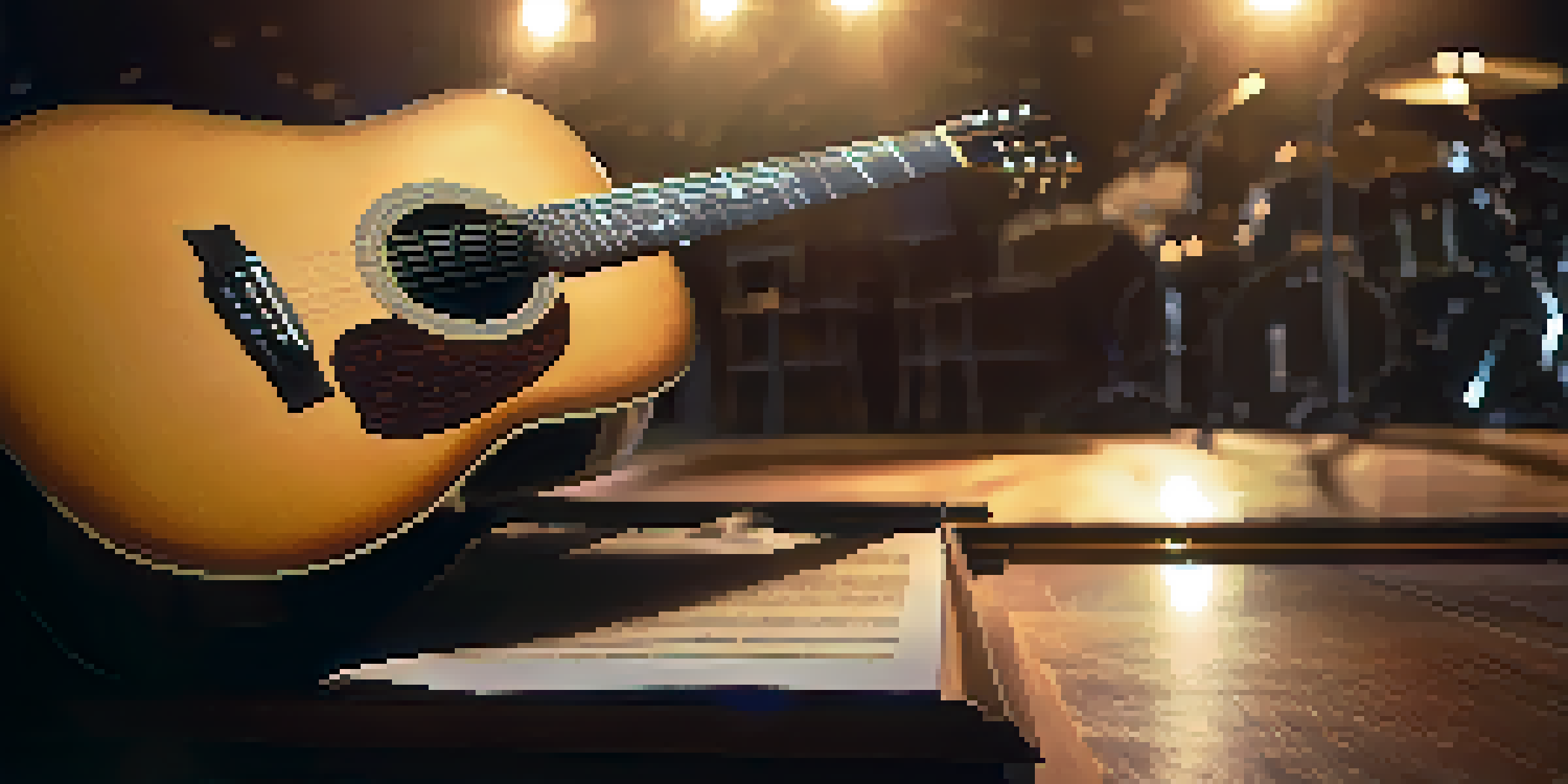Using Reverb to Enhance Acoustic Guitar in Live Settings

Understanding Reverb: What It Is and Why It Matters
Reverb, short for reverberation, refers to the persistence of sound in a space after the original sound has stopped. Think of it as the echo that fills a room, creating a sense of depth and dimension in music. In live settings, reverb can transform a flat acoustic guitar sound into a rich, immersive experience, enticing listeners and adding warmth to your performance.
Reverb is the echo that fills a room and makes sound feel alive.
When playing acoustic guitar, especially in larger venues, the natural sound can sometimes feel lost or thin. That’s where reverb comes in—it simulates the way sound behaves in different environments. By adding reverb, you make the sound fuller and more engaging, allowing it to resonate beautifully with the audience.
Understanding how to use reverb effectively is crucial for any performer. It’s not just about slapping on effects; it’s about enhancing the natural qualities of your instrument. The right amount of reverb can make your acoustic guitar shine, while too much can muddy the sound.
Types of Reverb: Choosing the Right One for Your Guitar
There are various types of reverb, each offering a unique flavor. Common types include plate, spring, hall, and room reverb. For acoustic guitar, hall reverb is often favored for its lush and spacious qualities, making it perfect for larger venues where you want the sound to fill the space.

On the other hand, room reverb can create a more intimate feel, ideal for smaller settings. It’s great for emphasizing the natural tone of the guitar without overwhelming it. By experimenting with different types of reverb, you can find the one that complements your playing style and the mood of your performance.
Reverb Adds Depth to Guitar Sound
Reverb enhances the acoustic guitar's natural qualities, making the sound fuller and more engaging for listeners.
Ultimately, the type of reverb you choose should enhance the acoustic guitar's presence without overshadowing it. Consider the atmosphere of your venue and the emotional impact you want to convey—this will guide you in selecting the best reverb type.
Setting Up Reverb: Basic Tips for Live Performances
Setting up reverb in a live setting involves balancing several factors, such as mix levels and the room's acoustics. Start with a moderate reverb setting; this allows you to gauge how it interacts with your guitar tone. Remember, less is often more—too much reverb can make your sound indistinct.
Music is the shorthand of emotion, and reverb adds depth to that expression.
Adjust the decay time, which is how long the reverb lasts after the initial sound. Shorter decay times can keep your sound crisp, while longer ones can create a lush soundscape. Finding the right decay time is essential for achieving a natural-sounding reverb that feels organic.
Lastly, consider using an EQ to shape the reverb effect. By filtering out certain frequencies, you can prevent muddiness and ensure clarity. This attention to detail will elevate your acoustic guitar sound, allowing it to resonate beautifully in live settings.
Common Mistakes: What to Avoid with Reverb
One of the most common mistakes musicians make is overusing reverb, leading to a washed-out sound. While it can add depth and ambiance, too much can make your acoustic guitar sound distant and unclear. Always strive for clarity; your audience should hear every note distinctly.
Another pitfall is neglecting the natural acoustics of the venue. Each room has its own sound characteristics, which can significantly affect how reverb behaves. Before you start tweaking settings, take a moment to listen to how your guitar sounds in the space and let that guide your adjustments.
Choosing the Right Reverb Type
Different types of reverb, like hall and room, can create distinct atmospheres, allowing musicians to tailor their sound to specific venues.
Lastly, avoid using the same reverb settings for every performance. Each venue is different, and your setup should reflect that. Tailoring your reverb to the specific location not only shows professionalism but also enhances the overall listening experience for your audience.
Live Performance Techniques: Using Reverb Effectively
Incorporating reverb into your live performance can enhance your playing style and engage your audience. Consider using it during specific sections of a song, like a bridge or solo, to create a dramatic effect. This intentional use of reverb can heighten the emotional impact of your music.
Another technique is to adjust reverb settings dynamically as you play. For instance, you might increase the reverb during a soft passage to create an ethereal atmosphere, then dial it back during more intense sections for clarity. This approach keeps the performance fresh and captivating.
Finally, practice with your reverb settings during rehearsals. This way, you’ll become comfortable with adjusting them on the fly. Being confident in your setup allows you to focus more on your playing and connection with the audience rather than fumbling with equipment.
Combining Reverb with Other Effects for Depth
While reverb is fantastic on its own, combining it with other effects can elevate your acoustic guitar sound even further. For instance, adding a touch of delay can create a beautiful echo that complements the reverb, enhancing the overall ambiance. This combination can make your music feel more expansive and engaging.
Another effect to consider is modulation, such as chorus or flanger. These can add richness and texture to your acoustic guitar tone, making it feel fuller. When combined with reverb, they can create a lush soundscape that resonates deeply with listeners.
Avoiding Common Reverb Mistakes
Overusing reverb or neglecting a venue's natural acoustics can lead to a muddled sound, so it's crucial to adjust settings based on each performance space.
However, moderation is key here as well. Too many effects can clutter your sound, leading to a chaotic listening experience. Experiment with different combinations during practice to discover what works best for your style and the mood you want to convey.
Final Thoughts: Mastering Reverb for Live Acoustic Guitar
Mastering reverb takes time and practice, but it’s worth the effort for any acoustic guitarist. By understanding the nuances of reverb and how it interacts with your instrument, you can transform your live performances into unforgettable experiences. Remember, the goal is to enhance the natural beauty of your guitar sound.
As you experiment with different reverb types, settings, and combinations, pay attention to how each adjustment affects your overall sound. This awareness will help you develop a signature style that resonates with your audience. The more you practice, the more confident you’ll become in your choices.

Ultimately, reverb is a powerful tool in your musical arsenal. Embrace it, experiment with it, and let it inspire your creativity on stage. With practice and care, you’ll find that the right reverb can turn a good performance into a truly memorable one.